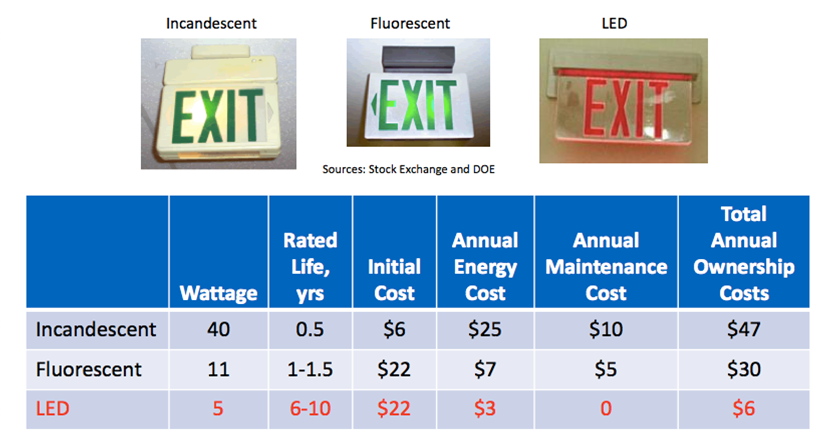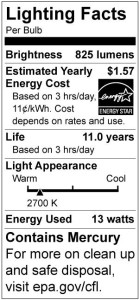In many cases the final decision to purchase a light bulb is simply “which one’s the cheapest!” With all the new energy efficient options, that choice is often the most expensive bulb to operate.
Understanding the factors that determine what The Energy Alliance Group calls the Total Life Cycle Cost of Ownership can make your light buying decisions much easier.
In a recent post we discussed how the marginal cost of operating an exit sign can be used as an example of hidden energy saving opportunities. We will compare 3 exit sign bulb choices to show you how to apply 6 factors and arrive at the most energy efficient choice.
These are the 6 steps that will help you make the most energy and cost effective choice for all your lighting needs:
Steps to Determine Total Life Cycle Cost of Lighting
- Bulb type – determine what type of bulbs are available. In this example we will compare: incandescent, fluorescent, and light emitting diodes (LED).
- Wattage – the amount of power needed to light the bulb. Normally listed on the package as “Energy Used”
- Rated Life Years – The manufacturers rating of how long the bulb is expected to last before needing replacement. Listed on the package label pictured above simply as “Life”.
- Initial Cost – The unit price of the bulb.
- Annual Energy Cost – The cost of the electricity needed to keep the bulb lit for the scheduled hours of illumination. The unit cost is specific to your community and your energy provider. Listed as an average on bulb labels as “Yearly Energy Costs”.
- Annual Maintenance – The labor cost of replacing bulbs. Does not include the cost of replacement bulbs. Bulbs with short life span will need to be replaced more often and have higher maintenance costs. In the example below you have to replace incandescent bulbs twice each year because the bulb only last half a year when lit continuously!
Exit Sign Total Annual Ownership Costs
Now let’s apply those factors to the choice of bulbs in an exit sign. Take the initial cost of the bulb and divide it by the rated life years. That gives you the yearly purchase cost of the bulb spread out over the bulbs projected lifetime (an incandescent bulb which has to be replace twice per year costs $12 even though the unit price is only $6). Add that figure to the cost of energy per year plus the annual maintenance cost and you arrive at the total annual ownership cost!
 As you can see the cheapest bulb has now become the most expensive to use when all factors are combined. With new bulb technology providing equivalent illumination at greatly reduced amounts of energy, and far greater lifespans, the options need to be looked at beyond simply the initial cost of bulbs.
As you can see the cheapest bulb has now become the most expensive to use when all factors are combined. With new bulb technology providing equivalent illumination at greatly reduced amounts of energy, and far greater lifespans, the options need to be looked at beyond simply the initial cost of bulbs.
Does your business have lots of lights that are on for long periods of time? A new free report details the “Ten Questions to Ask BEFORE An Energy Efficiency Upgrade.” The report is often the first step in reigning in the cost of wasted energy and increasing profitability. To receive the report click HERE!

Leave a Reply